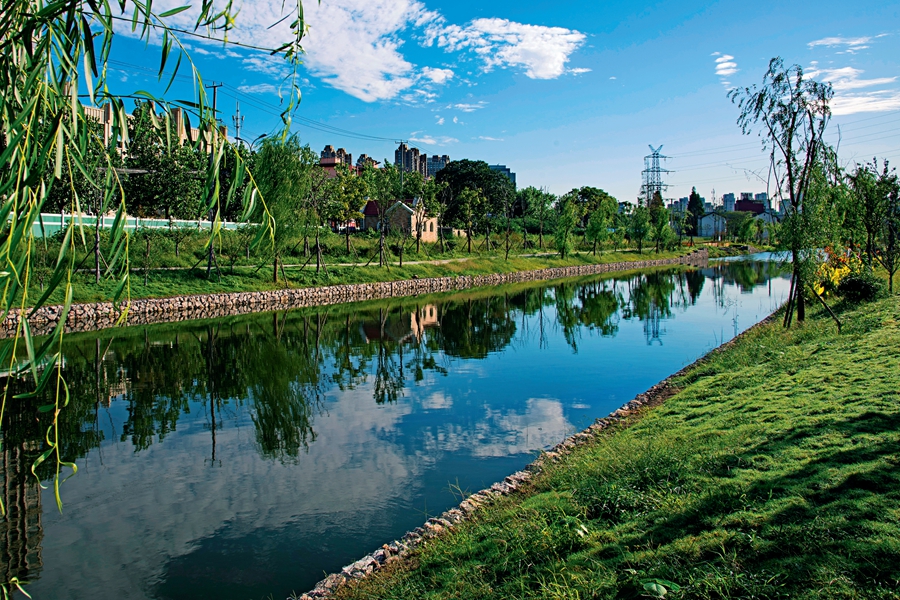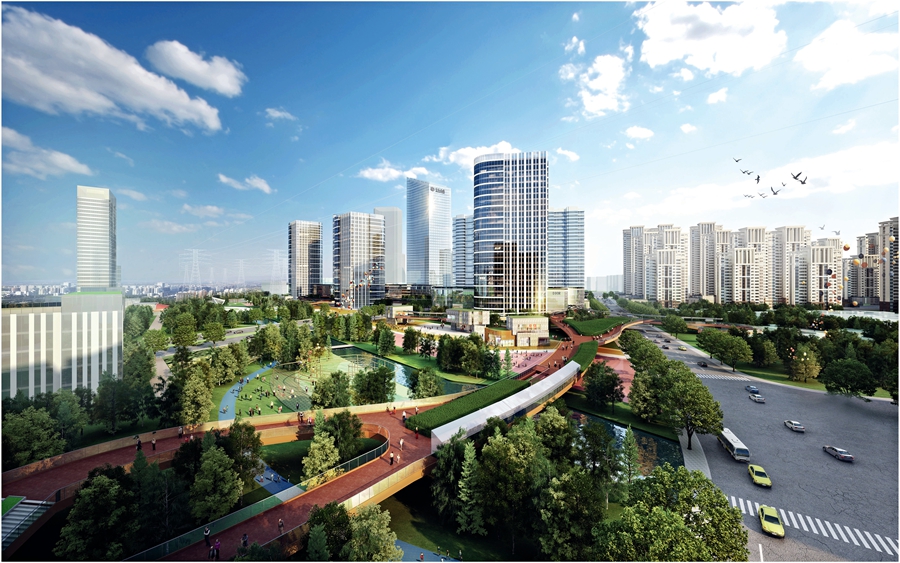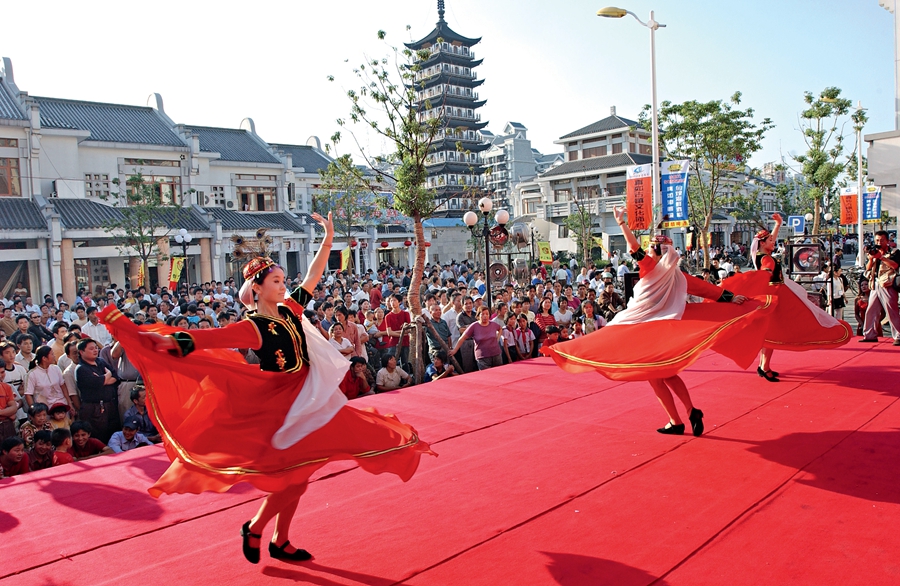A thrush flies into Zhenru Temple at dawn and rests in a ginkgo tree. This ancient temple that is over 700 years old began construction in the Jiading period (1208-1224) of the Song Dynasty and was completed in 1320. The bird watches the practicing Buddhist monks in chant from its perch in the tree.
The temple was originally called Wanshou Temple before monk Shi Yong’an refurbished and renamed it Zhenru Yuan. During the Yuan Dynasty the monk Shi Miaoxin moved it from Guanchang to Taopu, its present site, and renamed it Zhenru Temple, after which it became more famous. The name of “Zhenru” comes from the Buddhist sutra Vijnaptimatratasiddhi-sastra, which means as true as usual.

An ecological watercourse in Zhenru Sub-center of Shanghai.
After being expanded two times in the Ming Dynasty (1368-1644), once in the Hongwu period (1368-1398) and again in the Hongzhi period (1488-1505), the temple became the best of its kind nationwide. However, from the reign of Emperor Xianfeng (1851-1861) to the Chinese People’s War of Resistance against Japanese Aggression (1931-1945), it was devastated by the turmoil of war several times and suffered severe damage. Through this period only the main hall survived, but was in poor condition. After the founding of the People’s Republic of China, the government, while working in collaboration with both domestic and overseas monks, extended huge support to restoring this national and cultural treasure. In a time span of several years: the Hall of Heavenly Kings was rebuilt; The Yuantong Hall was repaired and a four-faced avalokiteshvara statue of white marble was placed inside; a prayer hall was built for worshiping the Buddha. In 1998 a nine-level pagoda in the Song Dynasty style was completed; and other reconstruction efforts were also executed. The Zhenru Temple has once again become a popular destination in Shanghai, with its towering pagoda and hallowed halls of Buddhist faith.
The revival not only came to the temple, but also to the 6.16 square kilometers Zhenru city sub-center, which is now the shining star of the orient.
Innovative Planning
In the master plan of Shanghai (1999-2020), Zhenru, together with Xujiahui, Wujiaochang and Huamu, is listed as the city’s four sub-centers.
The Zhenru sub-center boasts advantages of favorable location, convenient transportation, advanced planning, and rich cultural heritage. With the Shanghai West Railway Station, other positional advantages, and plenty of land, the Zhenru sub-center will develop into a service center covering the Yangtze River Delta and serve as a center for public events in northwestern Shanghai.
With the guidance of the latest master plan for Shanghai (2017-2035), the guiding principles of the 19th National Congress of the CPC, and the philosophy of focusing on innovation, humanism, and ecology, the Zhenru sub-center will continue with its efforts towards being a service center for the whole city and a sub-center for a world-leading modern socialist metropolitan.
At the requests of the central and municipal governments, Putuo District, taking into consideration its own and Zhenru’s conditions, has established an innovative development plan. Different from other sub-centers, Zhenru will have its own distinctive features. Integrating the world’s advanced urban construction philosophies and sophisticated urban systems, Zhenru sub-center has formulated green construction standards and adopted forward-looking plans and high standards for planning and construction. A visionary master plan for the region has been set up, with focus on innovation cluster and industry-city integration.

A planning visualization of Zhenru Sub-center in Shanghai.
After the 19th National Congress of the CPC, adjusting to the new conditions, Putuo District has adopted a philosophy of green, open, shared and innovative development with focus on ecology, culture, opening and sharing, and techological innovation. The Zhenru Sub-center Action Plan 2017-2021 was introduced to guide the development of the sub-center in order to utilize its late-comer advantage and distinguish it from other sub-centers.
The latest master plan for Zhenru emphasizes culture, ecology, and innovation. In terms of culture, Zhenru is one of the four famous towns in northern Shanghai (the other three Luodian, Dachang and Nanxiang). With long Wu and Yue cultural traditions, precious tangible and intangible cultural heritage sites such as the Zhenru Temple and the ancient Zhenru Town, it will be preserved to pass down the history and culture of the people as well as the local ecological culture of the ancient ginkgo trees. Zhenru Harbor and Liyuanbang will also be protected with the aim of promoting and rebuilding these regional cultural areas and their related traditions. In terms of ecology, the Zhenru ecological green corridor (six km long and 130-150 meters wide), which is presently being developed, will become the longest in Shanghai. Its construction will contribute to the open, green and livable environment and enhance Zhenru’s healthy, dynamic and cultural image by combining ecological restoration, outdoor activities, and urban culture. It will become a hub for cultural, sporting, and leisure activities. In terms of innovation, to contribute to Putuo’s functional layout of “one axis and two wings,” the Zhenru sub-center will form synergy with the Taopu region to enhance innovative development and to form a demonstration corridor for city transformation.
A Center of Culture and Commerce
Human traces in Zhenru date back to as early as the fifth and sixth century. The region is connected with dense waterways, making it a typical riverside town of the Yangtze River Delta. In 1320, Zhenru Yuan was moved to the vicinity of Taopu and renamed Zhenru Temple. This brought about massive development to the region. As large amounts of people migrated here, business and commerce flourished. Because of the temple, the region was named Zhenru. Before the Yuan Dynasty, people used to call this region Taoxi. The name Taoxi came into being in as early as the period of the Five Dynasties and Ten Kingdoms (907-960), when Jiangsu, Shanghai, and Zhejiang were ruled by the Wu and Yue kingdoms. The rulers began to dig 36 canals along the Wusong River from Suzhou to the sea. Taopu, traversing the ancient town from the south to the north, was one of the 36 waterways. Since peach trees were planted along this waterway, people called it Taoxi (river of peach).
Valuable cultural heritage is preserved in Zhenru to this day. Three examples of these cultural treasures are Zhenru mutton, soy bean products, and the Du cloth. They are still popular with the Shanghai people, of which the mutton is the most renowned. According to The Chronology of Zhenru, “…during the years of Qing Emperor Qianlong at 3:30 am every morning, peasants started their morning drink at teahouses; at around 4:30 am, they would order a dish of mutton and some liquor; they would finish breakfast with noodles in mutton soup and then go to the fields and work.” In its heyday 200 years ago, there were over 30 mutton restaurants in the old street alone. In June 2007, Zhenru mutton processing method was listed in the catalogue of intangible cultural heritage of Shanghai.
The stories of courage demonstrated by the people of Zhenru are also noteworthy, particularly their contribution to stopping Japanese aggression and their efforts to resist U.S. aggression and aid Korea. On the evening of January 28, 1932, Japanese marine corps assaulted the Zhabei region of Shanghai. The 19th Route Army of the Republic of China’s Revolutionary Army fought back, and the Shanghai Battle began. The commander of the 19th Route Army, Cai Tingkai, set up a temporary command at Fanzhuang, leading his troops in a 33-day battle with the Japanese army and causing the Japanese heavy losses. The temporary command was destroyed by the Japanese on August 3, 1937. In 1989, the Putuo District Government of Shanghai approved this battle relic to be a war memorial.

A folk art performance in Zhenru Town.
In 2013, at the Tongchuan Aquatic Products Market, consumers were quite amazed to find the internationally famous star Nicolas Cage among them. However, the shop owners were not surprised at all. This market is visited by many famous stars. Not far away from the aquatic market lies the Shanhua Fruits Market, which used to be the largest in eastern China, and was once a tourist attraction to both domestic and foreign visitors. It’s fair to say that the produce trade in Zhenru has made an important contribution to supplying non-staple food to residents in Shanghai and even the whole country. The commercial value of Zhenru has risen in accordance; rental of the most expensive shop of Shanhua Fruits Market in 2015 was even higher than that of the Wheelock Square in Jing’an District.
However, the speed at which Shanghai develops is always surprising. The once sought-after mode of business is not able to keep pace with Shanghai’s speed. Along with the transformation and upgrading of modes of business, primary-level commercial logistics are all gone, leaving a rare large piece of land in downtown Shanghai available. This land is Zhenru’s precious resource for transformation and has already attracted investment from famous international corporations like Cheung Kong Holdings, Greenland and Fosun. Top international design companies like Hentrich-Petschnigg & Partner GmbH + Co. KG, Ennead Architects and Gensler vied to bid for the 39 hectares of land in Hongqi Village in 2017.
A Regional Service Center
On the northeastern side of Tong-chuan Road and Caoyang Road, an over 300-meter-high skyscraper is being built. In front of it is the construction site of Line 14 Subway, which has already extended to 25 meters below the ground and will be built into a four-layer system. This depth has broken the 24-meter record of the Shanghai West Railway Station, which is also located in Zhenru.
Shanghai West Railway Station, completed in 2014, is the most modernized urban transportation hub in northwestern Shanghai, and is conveniently connected to depots of rail transit, buses and taxis. Its completion has made Zhenru a model of integrating the sub-center with a transportation hub. Regarding rail transit, Line 7 and Line 11, which are already in operation, and Line 14 and Line 15, which are under construction, and Line 20, which is being planned, will cover every part of the 6.16 square kilometers of Zhenru.
What’s more exciting is the renovation project of Hongqi Village. It aims to become a pilot region for innovation-driven transformation and an ecological area for residents and business, especially start-ups. It follows advanced urban development philosophies of integrating industries with cities, low-carbon green development, and humanized urban design. The three highlights “smart innovation city, energy conservation and environmental protection, and industries” will contribute to socio-economic development and peoples’ livelihood in the region.
The “smart innovation city” will shoulder important urban operation functions, and its design will be focused on smart technology and innovation. Intelligent computing technologies will make urban management, community service, property management, regional passenger traffic, public utilities, and public security more connected, efficient, and intelligent. BIM technologies and TOD model will make highly intense development within certain areas possible, allowing for more green lands and open spaces, while promoting city vitality and efficiency. To enhance public services and promote decision-making efficiency, a cloud data center will be built, utilizing Internet, and Internet of Things to collect and transmit data and other various information of the city. Such information will be analyzed, shared and, when possible, integrated.
Green development and environmental protection is the second highlight. President Xi Jinping has said on several occasions that “a good ecological environment is a benefit for all, and lucid rivers and lush mountains are invaluable assets.” Harmonious co-existence between human beings and nature is given top priority in the Hongqi Village project, with a waterway and a green corridor being planned. In the region circled by the waterway and corridor, a central island will be built, which will contain functions for business, residence, shopping, entertainment, and cultural activities. The pedestrian path will connect with a park of 500-year-old ginkgo trees, the Waterside Park, White Magnolia Park, Citizen Center and Elite Plaza. The region’s development will ensure the buildings are delightful, the streets are walkable, the parks are tranquil, and that the city is humane and inviting.
The third highlight will be industry-city integration, which is an inherent request of the region. With the philosophy of “working for living, working is living and working creates living,” Zhenru government works to create a model for integrating production, living, and ecological development. Four functional regions for tech innovation, interaction, leisure, and supporting facilities will be combined into one. There will be three cores: super-high office buildings and commercial-cultural malls, supporting facilities (apartment buildings, office buildings and public service facilities), and high-end residences (high-rise buildings with landscape views). Buildings for commerce, offices and residences as well as plazas will be built along the central park. In this way, the city will be able to showcase limitless vitality. Preferential policies will be introduced to attract high-caliber talents to make business start-ups flourish. Through attracting factors of production and good spatial layout, an industrial chain for scientific and technological innovation will be nurtured.
Great causes always require enduring efforts. Thanks to concerted efforts of the CPC municipal committee and the municipal government of Shanghai, the CPC committee and government of Zhenru District and people across the city, Hongqi Village and Zhenru sub-center as a whole have entered a fast track of transformative development. Zhenru will generate more social benefits, create considerable middle- and high-end jobs, optimize its industrial structure, contribute to the development of Shanghai, and become a service center in the Yangtze River Delta in the near future.
As the past historical glamour returns to Zhenru, it will cast its glorious radiance over the orient once more.
HU LIGANG is Party Secretary and chairman of Zhonghuan Group.